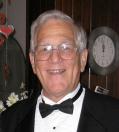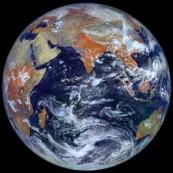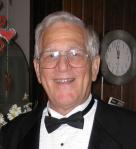World View in the 21st Century
There are more things in heaven and earth Horatio Than are dreamt of in our philosophy. —Shakespeare’s Hamlet

Anima Mundi
 Lest we allow our world view be shaped by scientists’ shallow materialistic view of a disenchanted universe, let us remember that the Earth is a living, breathing entity with a soul. It is the human species that has become disenchanted with its home among the stars by maintaining a materialistic view of the Earth, along with the entire Universe, a view that has turned living, soulful matter into potential resource to be harvested and ripped from the bowels of Earth—with eyes now on her sister planets—and used to build, power and feed a civilization that has overrun its boundaries in an exponential explosion of population, with its towering skyscrapers, sprawling subdivisions, and commercial and industrial complexes.
Lest we allow our world view be shaped by scientists’ shallow materialistic view of a disenchanted universe, let us remember that the Earth is a living, breathing entity with a soul. It is the human species that has become disenchanted with its home among the stars by maintaining a materialistic view of the Earth, along with the entire Universe, a view that has turned living, soulful matter into potential resource to be harvested and ripped from the bowels of Earth—with eyes now on her sister planets—and used to build, power and feed a civilization that has overrun its boundaries in an exponential explosion of population, with its towering skyscrapers, sprawling subdivisions, and commercial and industrial complexes.
The good Earth is burdened with concrete plastered all over her fertile, breathing soil, and with structures fabricated of iron and steel erected to refine oil and minerals drilled and dug up from her bowels to pave the way for commercial traffic and to fuel the engines of “progress,” a progress designed to enrich the few on the backs of the many. It hurts my heart to watch the cold, rigid iron and concrete paraphernalia of the oil industry intrude upon the wet and tender marshlands here in the South. Not a very pretty sight.
But “It’s what it is,” to borrow a coded line from The Irishman used to order a “hit”on some expendable gangster. We have reason to suspect our species may be expendable, seeing as how we are so susceptible to plagues such as the current outbreak of the coronavirus. Richard Tarnas paints a rather bleak and ominous picture of the modern world view in COSMOS AND PSYCHE:
The disenchanted cosmos impoverishes the collective psyche in the most global way, vitiating its spiritual and moral imagination—“vitiate” not only in the sense of diminish and impair but also in the sense of deform and debase. In such a context, everything can be appropriated. Nothing is immune. Majestic vistas of nature, great works of art, revered music, eloquent language, the beauty of the human body, distant lands and cultures, extraordinary moments of history, the arousal of deep human emotion; all become advertising tools to manipulate consumer response. For quite literally, in a disenchanted cosmos nothing is sacred. The soul of the world has been extinguished: Ancient trees and forests can then be seen as nothing but potential lumber; mountains nothing but mineral deposits; seashores and deserts are oil reserves; lakes and rivers, engineering tools. Animals are perceived as harvestable commodities, indigenous tribes as obstructing relics of an outmoded past, children’s minds as marketing targets. At the all important cosmological level the spiritual dimension of the empirical universe has been entirely negated, and with it any publicly affirmable encompassing ground for moral wisdom and restraint. The short term and the bottom line rule all. Whether in politics, business, or the media, the lowest common denominator of the culture increasingly governs discourse and prescribes the values of the whole. Myopically obsessed with narrow goals and narrow identities, the powerful blind themselves to the larger suffering and crisis of the global community.
In a world where the subject is experienced as living in—and above and against—a world of objects, other peoples and cultures are more readily perceived as simply other objects, inferior in value to oneself, to ignore or exploit for one’s own purposes, as are other forms of life, biosystems, the planetary whole. Moreover, the underlying anxiety and disorientation that pervade modern societies in the face of a meaningless cosmos create both the collective psychic numbness and a desperate spiritual hunger, leading to an addictive, insatiable craving for ever more material goods to fill the inner emptiness and producing a manic techno-consumerism that cannibalizes the planet. Highly practical consequences ensue from the disenchanted modern world view. . . .
Defined in the end by its disenchanted context the human self too is inevitably disenchanted. Ultimately it becomes, like everything else, a mere object of material forces and efficient causes: a sociobiological pawn, a selfish gene, a meme machine, a biotechnoligical artifact, an unwitting tool of its own tools. For the cosmology of a civilization both reflects and influences all human activity, motivation, and self-understanding that take place within its parameters. It is the container for everything else.”
The point Tarnas makes throughout his book is that we create our cosmology in our psyche and project that image out into the cosmos. We see the cosmos and our world not as they are but as we are.
Now is the time to remember our immortal Identity in Spirit and let go of our mortal identity in form; identity in transcendent Reality beyond and encompassing our humanity. The Spirit of God is moving upon the face of the sea of our collective consciousness commanding: “Let there be Light.” We are the Light-bearers for our world. It is the Spirit of God that inspires and enchants the cosmos. The presence of God, however, is not enough to lift the human psyche out of its fear, hatred and despair. Spirit needs to be expressed to be known. To have love in one’s heart is not sufficient. Love must be expressed, in words, with feeling and with action.
Cosmological Context for the 21st Century
Changing gears now, let’s have a look at what we may expect from the planetary configurations this century according to Richard Tarnas’ research.
For my readers who are not familiar with astrological terms for planetary alignments, here is a crash course. Planets in conjunction are lined up on the same side of the earth; in opposition on opposite sides; square alignments are at 90°; sextile at 60°; and trine at 120°.

Tarnas writes: (Emphasis mine)
We have discussed the various upcoming dynamic or hard-aspect alignments of the outer-planet cycles. There still remain the trines and sextiles of these cycles. Of these, by far the most significant is the century-long Neptune-Pluto sextile, which began in the mid-twentieth century and will continue until near the middle of the twenty-first. This long sextile takes place once each five-hundred-year Neptune-Pluto cycle, beginning about a half-century after the conjunction. Its unusual duration results from Pluto’s eccentric 248-year orbit, which twice each Neptune-Pluto cycle brings it close to and, briefly, even inside Neptune’s orbit—the first time as a sextile, the second as a trine. Historically, such sustained sextile or trine alignments of Neptune and Pluto have coincided with long epochs in which a certain profound evolution of consciousness appears to be propelled and sustained in a gradual, harmoniously unfolding manner, moving beneath and through the fluctuations and crises that might occur at a more immediate empirical level. The grand trine of Uranus, Neptune, and Pluto in the 1760’s and 1770’s cited in the previous chapter, which coincided with the peak of the Enlightenment, the birth of Romanticism, and the beginning of the American Revolution, occurred as part of the most recent much longer Neptune-Pluto trine of the eighteenth century. These century-long epochs generally seem to impel the collective experience of a more confluent relationship between nature and spirit, between evolutionary and instinctual forces (Pluto) and the spiritual resources and idealistic aspirations of the pervading cultural vision (Neptune). The archetypal dynamics involved characteristically provide, at an almost subterranean level in the collective psyche, a sustained stabilizing impulse.
This particular category of alignment has special significance: first, because it involves Neptune and Pluto, the two outermost planets; and second, because it lasts longer than any other planetary alignment. The current sextile is also historically noteworthy because of its role in the larger cyclical movements of all three outermost planets, since it coincided with the first Uranus-Pluto and Uranus-Neptune conjunctions to occur after the Neptune-Pluto conjunction of the 1880-1905 period. From a long-term historical perspective, therefore, we are living today at the moment when all three of these cycles, the largest planetary cycles known to us, have just completed their conjunctions in succession, marking the full initiation of the corresponding archetypal dynamics for the next several centuries.
If we consider, then, the unfolding cycles of the three outermost planets, taking into account the current alignment between Neptune and Pluto, the number of years since the most recent Neptune-Pluto conjunction a century ago, and the completion of the subsequent Uranus-Pluto and Uranus-Neptune conjunctions of the 1960’s and 1990’s, respectively, our present moment in history is most comparable, astronomically, to the period exactly five hundred years ago with which we began the book: the era that brought forth the birth of the modern self during the decades surrounding the year 1500. This too was an epoch of extraordinary turbulence and uncertainty, and also of great cultural creativity and dynamism. It was the moment of the High Renaissance of Leonardo and Michelangelo, Erasmus and Thomas More, in the immediate aftermath of PicodelIa Mirandola’s new vision of human possibility in the Oratia and Ficino’s Platonic Academy in Florence-a period shaped by the rapid spread of a powerful new medium of universal communication, the printed book; the first expeditions to a vast new world that, at enormous human and ecological cost, led to the opening of the global community to itself; and the immense spiritual and cosmological transformations, still unfolding, represented by Luther’s start of the Reformation and Copernicus’s conceiving of the heliocentric hypothesis.
Our postmodern age of ceaseless flux and irresolvable complexity, for all its metaphysical disorientation, and despite the collective entrancement produced by the mass media and corporate marketing, has nevertheless brought forth new conditions and possibilities that could prove invaluable for our future. As a result of the many extraordinary changes—cultural, psychological, spiritual—that have unfolded in the past half-century, the collective psyche has undergone a pervasive and in certain respects deeply benign transformation that cannot easily be measured and yet, for all its subtlety, is no less pregnant with historical significance. The rapid dissemination during this era of a fundamental new openness to the perspectives and realities of different cultures, eras, religions, races, classes, genders, sexual orientations, age groups, even different species and forms of life has been an essential characteristic of our time. It is perhaps not too much to say that, in this first decade of the new millennium, humanity has entered into a condition that is in some sense more globally united and interconnected, more sensitized to the experiences and suffering of others, in certain respects more spiritually awakened, more conscious of alternative future possibilities and ideals, more capable of collective healing and compassion, and, aided by technological advances in communications media, more able to think, feel, and respond together in a spiritually evolved manner to the world’s swiftly changing realities than has ever before been possible.
All of this is, of course, occurring below the radar of the mass media. To paraphrase Shakespeare’s line from Hamlet: There are more things in heaven and earth than are reported by the media. There is a saying about the content guidelines for media coverage: “If it bleeds it leads. If it tells it sells.”
Attunement with the material world has kept human beings earthbound in a “dust-to-dust” mindset. We are called to a Light-to-Light level of consciousness and to a greater awareness of being more than “only human.”
Consumed by Fire
There is a groundswell of spiritual awakening that’s been growing since the 1960’s. Many who have sufficient resonant substance are being drawn by Love to find attunement with the Tone sounding in the center of our Milky Way Galaxy where the design for a New Earth is established in a New Heaven. With the current cosmic configuration of stars and planets in our solar system and galaxy, we have the support of the entire Universe to move to a higher dimension and to transform our world by the fire of love into a Paradise—the topic of my next blog series. Until then,
Be love. Be loved.
Anthony
tpal70@gmail.com
 Thank you, Rumi, for your rumination. The world is indeed too full to talk about, so I will simply write about it. In this series, I’ve been considering the history of archetypes and its parallel evolution with that of human consciousness. The source of my research is Richard Tarnas’ epic book COSMOS AND PSYCHE, which I am finding incredibly fascinating and enlightening a read and study.
Thank you, Rumi, for your rumination. The world is indeed too full to talk about, so I will simply write about it. In this series, I’ve been considering the history of archetypes and its parallel evolution with that of human consciousness. The source of my research is Richard Tarnas’ epic book COSMOS AND PSYCHE, which I am finding incredibly fascinating and enlightening a read and study.  It is not by happenstance that this material has come into my hands just prior to the time of the current planetary alignment, which will end on February 20th, two days before this post will be published. My consciousness is attuned to the energetic messages being transmitted to Earth at this pivotal and chaotic time when the most powerful person in man’s world is about to be chosen by the citizens of the United States of America—who are divided amongst themselves with fear and hatred governing hearts and minds. There is an encoded message for us in the music streaming from these aligned spheres, and one message I am hearing is
It is not by happenstance that this material has come into my hands just prior to the time of the current planetary alignment, which will end on February 20th, two days before this post will be published. My consciousness is attuned to the energetic messages being transmitted to Earth at this pivotal and chaotic time when the most powerful person in man’s world is about to be chosen by the citizens of the United States of America—who are divided amongst themselves with fear and hatred governing hearts and minds. There is an encoded message for us in the music streaming from these aligned spheres, and one message I am hearing is 
 Our conscious presence in a cosmic context has been more vividly and visually brought to our awareness, as well as recalled to remembrance, by pictures of the vast cosmos made with the Hubble Telescope and shared with the world by our tenaciously adventurous astronomers who keep peering deeper and deeper into the “dark space” around us.
Our conscious presence in a cosmic context has been more vividly and visually brought to our awareness, as well as recalled to remembrance, by pictures of the vast cosmos made with the Hubble Telescope and shared with the world by our tenaciously adventurous astronomers who keep peering deeper and deeper into the “dark space” around us. 
 I rarely ever read my horoscope in the daily newspaper. Born on the cusp of Taurus and Gemini, I’m usually undecided about which sign is more influential in my life. Most likely Gemini, as I tend to avoid making decisions and simply do what’s obviously needed in the moment.
I rarely ever read my horoscope in the daily newspaper. Born on the cusp of Taurus and Gemini, I’m usually undecided about which sign is more influential in my life. Most likely Gemini, as I tend to avoid making decisions and simply do what’s obviously needed in the moment.
 I enjoy reading books whose authors agree with my way of thinking and resonate with my depth of knowing. Don’t we all? COSMOS AND PSYCHE, authored by Richard Tarnas, is such a book whose author I’ve come to know and regard as a soul brother and kindred spirit. Although he uses large words and long sentences at times, his spirit flows through the lines and between the pages with unfettered authenticity. He is a joy to read, and I am happy to share that joy here,
I enjoy reading books whose authors agree with my way of thinking and resonate with my depth of knowing. Don’t we all? COSMOS AND PSYCHE, authored by Richard Tarnas, is such a book whose author I’ve come to know and regard as a soul brother and kindred spirit. Although he uses large words and long sentences at times, his spirit flows through the lines and between the pages with unfettered authenticity. He is a joy to read, and I am happy to share that joy here,